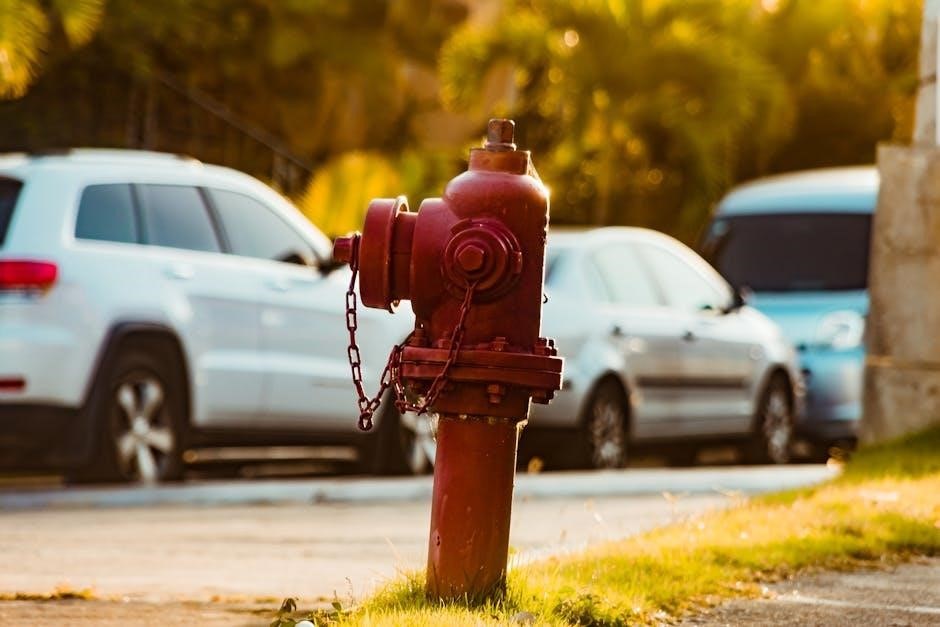The AASHTO Roadside Design Guide provides comprehensive guidelines for designing safe roadways, focusing on clear zones, slopes, and barriers to minimize crash severity and enhance safety.
1.1 Purpose and Scope of the Guide
The AASHTO Roadside Design Guide aims to provide comprehensive design principles for roadside safety, ensuring roads are built to minimize crash severity and enhance safety. Its scope covers clear zones, slopes, barriers, and drainage, offering dual-unit measurements for versatility. The guide synthesizes current practices and research, updated regularly to reflect advancements. It serves as a critical resource for engineers and designers, ensuring consistency with AASHTO and FHWA standards while addressing practical challenges in roadside design. The guide emphasizes structural adequacy, visibility, and sustainability, making it indispensable for modern transportation infrastructure development.
1.2 Importance of Roadside Safety
Roadside safety is critical for reducing crash severity and saving lives. Effective design minimizes hazards, such as steep slopes or obstacles, ensuring vehicles can safely recover if they leave the roadway. Clear zones and proper drainage reduce accident risks, while vegetation management and barrier placement protect motorists. Adhering to AASHTO guidelines ensures consistency and optimal safety outcomes, making it a cornerstone of modern transportation engineering. By prioritizing roadside safety, engineers create resilient infrastructure that supports public welfare and mobility, aligning with broader traffic safety goals and community protection.
1.3 Overview of Key Concepts
The AASHTO Roadside Design Guide covers essential elements for safer roadways. Key concepts include clear zones, which are unobstructed areas beside roads, and proper slope designs to prevent erosion and accidents. Drainage systems are emphasized to manage water effectively, reducing hazards like flooding. Vegetation management ensures visibility and stability, while roadside barriers protect against collisions. The guide also addresses structural adequacy of signs and lighting, promoting energy efficiency. These principles, integrated with AASHTO’s broader standards, form a comprehensive approach to enhancing roadside safety and maintaining infrastructure durability, ensuring safer travel for all road users while adhering to current engineering practices and sustainability goals.

History and Evolution of the AASHTO Roadside Design Guide
The AASHTO Roadside Design Guide has evolved over decades, with the 4th Edition published in October 2011, incorporating updated safety standards and practices for roadside design.

2.1 Development of the Guide
The AASHTO Roadside Design Guide was developed to standardize safety measures, beginning with initial editions focused on crash data and field practices. Over time, it incorporated advancements in materials and technology, ensuring adaptable and reliable guidelines for engineers. The guide’s creation involved collaboration between state transportation agencies and safety experts, aiming to reduce accidents and enhance roadside safety. Its development reflects a commitment to evidence-based practices, continually updated to address emerging challenges in highway safety.
2.2 Major Updates and Revisions
The AASHTO Roadside Design Guide has undergone significant updates to reflect advancements in safety research and engineering practices. The 4th Edition, published in 2011, introduced revised clear zone guidelines, enhanced barrier crash testing protocols, and updated drainage and vegetation management standards. Recent technical revisions have further refined design accelerations and structural adequacy criteria for signs and lighting. These updates ensure the guide remains aligned with current safety priorities and technological advancements, providing engineers with practical tools to design safer roadways and reduce crash risks effectively.
2.3 Current Edition (4th Edition)
The 4th Edition of the AASHTO Roadside Design Guide, published in 2011, represents the most recent comprehensive update to the manual. It incorporates extensive research and field experience, focusing on enhanced safety measures such as updated clear zone dimensions, improved barrier designs, and advanced drainage solutions. This edition also emphasizes the importance of structural adequacy for traffic signs and lighting, ensuring they can withstand various environmental and operational stresses. The guide is widely distributed, including to FHWA field offices, and serves as a dual-unit reference, making it accessible to engineers across different regions and project requirements.

Key Principles of Roadside Design
The AASHTO Roadside Design Guide emphasizes clear zones, slope stability, erosion control, proper drainage, and vegetation management to ensure roadside safety and durability.
3.1 Clear Zones and Their Significance
Clear zones are unobstructed areas beside roadways designed to reduce crash severity by allowing vehicles to safely recover or come to a stop. Typically, clear zones are 30 feet wide, adjusted based on road speed and traffic volume. Proper design and maintenance are crucial for safety. Regular inspections ensure no obstacles are present. Clear zones are a key principle in roadside design, enhancing overall safety by providing a buffer. Their implementation is guided by AASHTO standards, ensuring consistency nationwide, and are vital for minimizing crash impacts and protecting road users.
3.2 Slope and Erosion Control
Slope design is critical for roadside safety, ensuring vehicle stability and preventing crashes. The AASHTO guide recommends slopes that balance safety with environmental considerations. Proper grading minimizes erosion risks, maintaining road integrity. Vegetation and drainage systems are key to controlling erosion. Design must account for soil types, water flow, and long-term maintenance. Slopes should align with predicted design accelerations to ensure safety. Regular inspections and repairs prevent hazards. Effective slope and erosion control enhances safety, reduces maintenance costs, and protects the environment, aligning with AASHTO’s guidelines for sustainable and resilient infrastructure.
3.3 Drainage Considerations
Proper drainage is essential for roadside safety and infrastructure durability. The AASHTO Roadside Design Guide emphasizes designing drainage systems to manage water flow effectively. This includes ditching, culverts, and stormwater management systems. Adequate drainage prevents erosion, reduces hydroplaning risks, and maintains clear zones. Designers must consider soil types, water flow rates, and environmental impacts. Regular inspections and maintenance of drainage systems are critical to ensure functionality. Poor drainage can lead to safety hazards and structural damage. By integrating sustainable practices, the guide promotes efficient water management, enhancing both safety and environmental protection along roadways.
3.4 Vegetation Management
Effective vegetation management is critical for maintaining roadside safety and visibility. The AASHTO Roadside Design Guide recommends regular maintenance to control plant growth within clear zones, ensuring driver visibility and reducing crash risks. Techniques include mowing, herbicides, and selective planting. Proper vegetation management also prevents obstruction of traffic signs, lighting, and drainage systems. Additionally, managing invasive species helps protect ecosystems and maintain infrastructure integrity. Balancing safety with environmental considerations, the guide promotes sustainable practices to enhance roadside aesthetics while prioritizing motorist safety and structural durability. Regular inspections and seasonal maintenance are essential to uphold these standards and ensure long-term roadside functionality.

Roadside Barriers and Hardware
Roadside barriers and hardware are essential for enhancing safety by protecting against crashes and reducing severe impacts. The guide provides specifications for crashworthy performance and installation.
4.1 Types of Roadside Barriers
Roadside barriers are critical for preventing vehicles from leaving the roadway and reducing crash severity. Common types include metal guardrails, concrete barriers, and cable barriers. Each design offers unique benefits, such as durability, crashworthiness, and flexibility. Metal guardrails are widely used for their cost-effectiveness and ability to redirect vehicles. Concrete barriers provide superior strength and are often used in high-traffic areas. Cable barriers are ideal for medians due to their tensile strength and ability to absorb impact. Selection depends on site-specific conditions, including speed limits, traffic volume, and terrain. Proper installation ensures barriers perform effectively in real-world crashes, enhancing roadside safety.
4.2 Crash Testing and Performance Criteria
Crash testing is a critical component of evaluating roadside barriers’ effectiveness. The AASHTO Roadside Design Guide outlines rigorous testing protocols to assess how barriers perform during collisions. These tests simulate real-world scenarios, measuring factors such as vehicle deceleration, occupant risk, and barrier integrity. Performance criteria ensure barriers meet safety standards, reducing injury severity and preventing fatalities. Testing also evaluates whether barriers successfully redirect vehicles or absorb impact forces. The results help engineers select appropriate barriers for specific roadway conditions, ensuring optimal safety outcomes while minimizing maintenance needs. Compliance with these criteria is essential for maintaining roadway safety standards nationwide.
4.3 Maintenance and Inspection
Regular maintenance and inspection of roadside barriers are crucial for ensuring long-term safety and performance. The AASHTO Roadside Design Guide emphasizes the importance of routine checks to identify damage, corrosion, or wear. Maintenance activities include repairing damaged sections, replacing worn components, and cleaning debris that may obstruct visibility. Inspection schedules vary based on traffic volume and environmental conditions, with high-risk areas requiring more frequent assessments. Proper upkeep not only extends the service life of barriers but also maintains their crashworthiness, ensuring they continue to protect road users effectively. Timely interventions prevent minor issues from becoming major safety hazards.

Traffic Signs and Lighting
Traffic signs and lighting are essential for guiding drivers and ensuring visibility. The guide provides standards for structural support, visibility, and energy-efficient solutions to enhance safety.
5.1 Structural Adequacy of Support Structures
Structural adequacy ensures traffic signs, luminaires, and signals are securely supported. The guide specifies design requirements for load calculations, material strength, and installation to withstand environmental and operational stresses. Compliance with AASHTO standards guarantees durability and safety, minimizing risks of structural failure. Proper engineering ensures supports can bear weights of devices and resist wind, ice, and seismic forces. Regular inspections and maintenance are emphasized to maintain structural integrity over time. These guidelines help engineers design reliable support systems that protect both infrastructure and road users.
5.2 Visibility and Placement Guidelines
Visibility and placement guidelines ensure traffic signs and lighting are easily seen by drivers. The guide specifies requirements for sign height, letter size, and reflectivity to enhance visibility, especially at night or in low-light conditions. Proper placement considers driver behavior, speed limits, and road geometry to ensure timely recognition and comprehension of signs. Clear lines of sight and minimal visual clutter are emphasized to prevent distractions. These standards help maintain consistent messaging and reduce crash risks by ensuring drivers can quickly understand and respond to roadway information. Proper placement also accommodates varying vehicle heights and driver eye levels for optimal visibility.
5.3 Energy Efficiency and Sustainability
Energy efficiency and sustainability are key focuses in modern roadside design. The guide promotes the use of LED lighting for its low power consumption and long lifespan, reducing energy costs and environmental impact. Solar-powered options are also encouraged for illumination in remote areas, minimizing reliance on grid electricity; Additionally, sustainable materials are recommended for sign structures and barriers, lowering their carbon footprint. These practices align with broader environmental goals, ensuring roadside infrastructure is both safe and eco-friendly. By integrating energy-efficient technologies, the guide supports long-term cost savings and reduced maintenance while promoting greener transportation solutions.

Roadside Safety Analysis and Simulation
The guide emphasizes crash analysis and simulation tools to predict design accelerations and assess risks, ensuring safer roadside features through advanced computer-aided design and testing methods.
6.1 Predicting Design Accelerations
Predicting design accelerations is crucial for assessing roadside safety. The guide provides methodologies to estimate impact forces and vehicle decelerations, ensuring structures can withstand crashes. Advanced simulation tools and field data analysis are recommended to refine predictions. These methods help designers evaluate barrier performance and optimize safety features. Accurate acceleration predictions ensure compliance with safety standards and minimize collision risks. The guide also emphasizes integrating acceleration data with other design elements, such as slopes and drainage, to create a holistic safety framework. This approach enhances overall roadside safety and reduces potential hazards for drivers.
6.2 Crash Analysis and Risk Assessment
Crash analysis and risk assessment are essential for evaluating roadside safety. The guide provides methods to analyze crash data, identify high-risk areas, and assess potential hazards. By considering factors like vehicle speed, accident history, and obstacle placement, designers can prioritize safety measures. Risk assessment helps determine the likelihood and severity of collisions, guiding the selection of appropriate barriers and safety features. Regular analysis ensures designs adapt to emerging trends and reduce long-term accident risks, promoting safer road environments for all users while adhering to AASHTO standards.
6.3 Computer Modeling and Simulation Tools
Computer modeling and simulation tools play a vital role in modern roadside design by enabling precise analysis of safety features. These tools simulate real-world scenarios, such as vehicle impacts and barrier performance, to predict design accelerations and potential outcomes. Advanced software allows engineers to test various configurations virtually, reducing the need for physical prototypes. Simulations also help assess crashworthiness and optimize barrier systems for different road conditions. By integrating these tools, designers can enhance safety, reduce costs, and ensure compliance with AASHTO standards, ultimately creating safer and more efficient road environments.

Integration with Other AASHTO Manuals
The AASHTO Roadside Design Guide aligns with other AASHTO manuals, such as Geometric Design Standards and the Highway Safety Manual, to ensure cohesive transportation infrastructure planning and safety.
7.1 Geometric Design Standards
The AASHTO Roadside Design Guide integrates with geometric design standards to ensure consistency in highway design. These standards provide guidelines for aligning roadside features, such as slopes and barriers, with the overall roadway geometry. By adhering to these principles, engineers can create safer and more functional roadways. The guide emphasizes the importance of harmony between roadside elements and the highway’s geometric layout to minimize hazards and maintain smooth traffic flow. This alignment ensures that safety measures are seamlessly incorporated into the broader design framework, promoting a cohesive approach to transportation infrastructure development.
7.2 Highway Safety Manual (HSM)
The Highway Safety Manual (HSM) is integrated with the AASHTO Roadside Design Guide to enhance safety analysis and assessment; It provides methodologies for predicting crash frequencies and evaluating the effectiveness of safety improvements. By incorporating quantitative tools, the HSM supports the Guide’s objectives in reducing crashes and enhancing roadside safety. This integration allows engineers to assess risks more accurately and make data-driven decisions. The HSM’s focus on safety performance aligns with the Guide’s emphasis on designing safer roadways, ensuring a comprehensive approach to minimizing hazards and improving traffic safety overall.
7;3 Transportation Asset Management
Transportation Asset Management (TAM) integrates with the AASHTO Roadside Design Guide to ensure effective management of transportation infrastructure. The guide supports TAM by providing design standards that align with asset management goals, such as optimizing safety, durability, and cost-effectiveness. By incorporating TAM principles, the guide helps agencies maintain and improve roadside assets, ensuring long-term performance and minimizing lifecycle costs. This integration enables transportation professionals to make informed decisions about resource allocation, prioritizing improvements that enhance safety and operational efficiency while aligning with broader organizational objectives.

Case Studies and Examples
Real-world applications of the AASHTO Roadside Design Guide demonstrate its effectiveness in improving safety. Case studies highlight successful implementations, such as guardrail installations and clear zone optimizations, showcasing reduced accident rates and enhanced roadside safety.
8.1 Successful Implementation of Roadside Design Guide
Successful implementation of the AASHTO Roadside Design Guide has been demonstrated through various projects nationwide. For instance, guardrail installations along highways have significantly reduced accident severity. Clear zone optimization has minimized collision impacts, while vegetation management has improved visibility. These real-world applications highlight the guide’s practicality and effectiveness in enhancing roadside safety. By adhering to the guide’s principles, transportation agencies have achieved measurable safety improvements, validating the importance of evidence-based design practices. These examples serve as benchmarks for future projects, showcasing how effective roadside design can save lives and reduce crash-related costs.
8;2 Lessons Learned from Real-World Applications
Real-world applications of the AASHTO Roadside Design Guide have revealed valuable lessons. One key takeaway is the importance of proper guardrail installation to ensure crashworthiness. Additionally, vegetation management practices must balance safety with environmental concerns. Maintenance challenges, such as erosion control and drainage issues, highlight the need for regular inspections. Lessons from past projects emphasize the value of adapting designs to site-specific conditions and collaborating with stakeholders. These insights underscore the importance of continuous improvement and practical adjustments to enhance roadside safety and durability, ensuring the guide remains effective in varying environments and conditions.

Future Trends and Innovations
Future trends include integrating smart technologies and sustainable materials into roadside designs, enhancing safety through data-driven approaches and advanced simulation tools for improved crash analysis and risk mitigation.
9.1 Advancements in Materials and Technology
Advances in materials and technology are revolutionizing roadside design, with high-tensile steel and fiber-reinforced polymers offering enhanced durability. Smart technologies, like impact attenuation devices and intelligent transportation systems (ITS), improve safety by monitoring real-time conditions. These innovations align with sustainability goals, reducing environmental impact while maintaining performance. The 4th Edition of the AASHTO Roadside Design Guide highlights dual-unit measurements, reflecting global design practices. Such advancements ensure safer, more resilient infrastructure, meeting current standards and future challenges effectively.
9.2 Integration of Smart Roadside Systems
Smart roadside systems integrate advanced technologies like intelligent transportation systems (ITS) and real-time monitoring to enhance safety and efficiency. These systems utilize sensors, IoT devices, and data analytics to optimize traffic flow and incident response. Energy-efficient lighting and connectivity solutions reduce environmental impact while improving visibility. The AASHTO Roadside Design Guide supports these innovations, ensuring seamless integration with existing infrastructure. By leveraging smart technologies, roadways become safer, more adaptive, and sustainable, aligning with modern transportation demands and fostering a connected, efficient transportation network for future generations.
The AASHTO Roadside Design Guide serves as a cornerstone for ensuring safety and efficiency in transportation infrastructure. By addressing clear zones, barriers, and smart systems, it balances safety with environmental and economic considerations. Continuous updates reflect evolving technologies and practices, making it a vital resource for modern transportation. The guide’s comprehensive approach supports engineers in creating resilient and sustainable roadways, ultimately reducing crashes and enhancing mobility for all users. Its integration of innovation and proven standards underscores its enduring relevance in advancing roadside safety.
